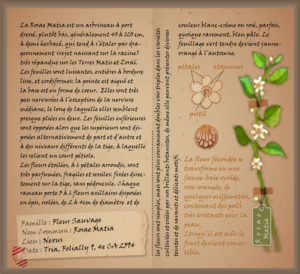From EncyclopAtys
The last editing was from Lanstiril on 9.08.2019.
| Taxonomic Amber | |
| Herbarium written in Avalae dialect | |
|---|---|

| |
| Kingdom | {{{king}}} |
| Category | {{{species}}} |
| Main Ecosystem(s) | Forest, Jungle, Nexus |
| Counterattack type | n.a. |
Description
The rosae Matia (or fragaria) is an upright shrub, rather low, generally 40 to 120 cm, half herbaceous, which tends to spread by suckering (offshoot emerging on the root) very common on Matis and Zoraï lands.
The leaves are shiny, whole with a smooth border, cordiform: the tip is sharp and the base is heart-shaped. They are very slightly ribbed except for the median rib, along which they appear almost folded in half. The lower leaves are opposite while the upper ones are alternately disposed on either side and at different levels of the stem, to which a short petiole connects them. The starry flowers, with 6 rounded petals, are very fragrant, fragile and sessile: directly fixed on the stem, without peduncle. Each shoot has 3 to 6 axillary flowers arranged in ears, isolated, from 2 to 4 cm in diameter and creamy-white or pinky or, more rarely, pale blue in colour. The soft green foliage turns orange-yellow at fall.
Uses
Rosae, easy to cultivate on drained and sunny soil, is appreciated for its ornamental qualities and the production of perfumes or sweets. The fertilized flower turns into a fake ovoid, pinkish-orange, a few millimetres long, containing hairs that are very irritating to the skin. When ripe, the fruit becomes edible.
Notes
Many amateurs and scholars – because it is an integral part of botanists' training – are engaged in its hybridization. The rosae Matia is the oldest known rosae and most of the current varieties are affiliated with it. The number of varieties resulting from mutations or crossbreedings that have occurred is estimated to be several hundred, but barely a dozen have been preserved so far.
According to custom, hybrids are named after famous places or characters, such as members of royal families, such as the legendary rosae Yrkanis, which, alone after Rosae Matia, has been able to acclimate and grow spontaneously.
The flowers are single, but are more commonly double or even triple in the varieties cultivated and created by our brilliant botanists, just as they can have various shades and clever, delicate patterns.
| |
| |



